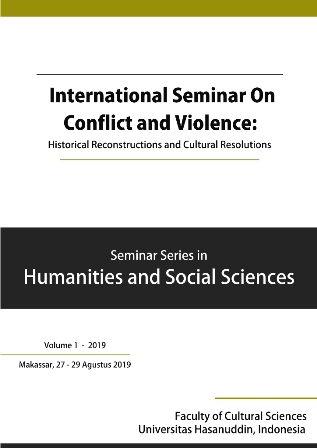Conciliation or confrontation: Chinese responses to anti-Chinese violence in North Sumatra during the Indonesian revolution, 1945-1949
Abstract
“Gajah berjuang sama gajah, pelanduk mati di tengah-tengah (or when two great powers fight, the people in between become the victim).” This old Indonesian saying was cited by a Chinese newspaper from Medan in April 1947 to describe the situation of Chinese people in Indonesia. Chinese people had become victims of violence during the Indonesian revolution, especially in places where military conflict between Indonesian forces and Dutch forces took place. This paper focuses on the responses of Chinese people and their organisations to anti-Chinese violence in North Sumatra during the revolution. Concentrating - at specific turning points - on external interventions, internal tensions, and social networks, it will be shown that Chinese people in North Sumatra employed divergent strategies of response to protect themselves against violence. Ranging between expressing support for Indonesian independence and promoting solidarity between the Chinese people and the Indonesian people on the one hand, and armed confrontation and the “use violence against violence” on the other hand, responses violence became increasingly divided between conciliation and outright confrontation. Finally, the effect of the strategies of conciliation and confrontation will be assessed.
Keywords: Indonesian national revolution, North Sumatra, violence, ethnicity.References
Archival sources
- Nationaal Archief (Den Haag), Algemene Secretarie van de Nederlands-Indische Regering en de daarbij gedeponeerde Archieven, 2.10.14: 3100.
- Nationaal Archief (Den Haag), Netherlands Forces Intelligence Service [NEFIS] en Centrale Militaire Inlichtingendienst [CMI] in Nederlands-Indië, 2.10.62: 636, 725, 1566, 3950, 5404.
- Nationaal Archief (Den Haag), Ministerie van Defensie: Archieven van de Strijdkrachten in Nederlands-Indië, 2.13.132: 1340.
- Nationaal Archief (Den Haag), Ministerie van Koloniën: Supplement, 1826-1952, 2.10.03: 86, 87.
- Nationaal Archief (Den Haag), Procureur-Generaal bij het Hooggerechtshof van Nederlands-Indië, 1945-1950, 2.10.17: 679.
Newspapers- Berita Antara, Jakarta
- Kerakjatan, Medan
- Soeloeh Merdeka, Medan
- Qianjin Zhoubao, Medan
LiteratureAkashi, Yoji, The Nanyang National Salvation Movement, 1937-1941 (Lawrence: Center for East Asian Studies, University of Kansas, 1970).
Biro Sejarah PRIMA [Pejuang Republik Indonesia Medan Area], Medan Area Mengisi Proklamasi: Perjuangan Kemerdekaan dalam Wilayah Sumatera Utara (Medan: Badan Musyawarah Pejuang Republik Indonesia Medan Area, 1976)
Buiskool, Dirk A., ‘The Chinese Commercial Elite of Medan, 1890-1942: The Penang Connection,’ Journal of the Malaysian Branch of the Royal Asiatic Society 82:2 (2009) 113-129.
Fung, Edmund S.K., In search of Chinese democracy: civil opposition in Nationalist China, 1929-1949 (Cambridge: Cambridge University Press, 2000).
Fusuyama, Takao, A Japanese memoir of Sumatra, 1945-1946: love and hatred in the liberation war (Ithaca, YN: Cornell Modern Indonesia Project Monograph Series no 71, 1993).
Godley, Michael R., ‘Thio Thiauw Siat’s Network,’ in: John Butcher and Howard Dick (eds.), The Rise and Fall of Revenue Farming: Business Elites and the Emergence of the Modern State in Southeast Asia (New York: St. Martin’s Press, 1993) 262-271.
Hamka, Kenang-kenangan hidup (Kuala Lumpur: Penerbitan Pustaka Antara, 1966).
Nasrul Hamdani, Komunitas Cina di Medan dalam Lintasan Tiga Kekuasaan 1930-1960 (Jakarta: LIPI Press, 2013).
Kwee Tek Hoay, The Origins of the Modern Chinese Movement in Indonesia [translated by Lea E. Williams] (Ithaca, N.Y.: Cornell Modern Indonesia Project, Translation Series, 1969).
McKeown, Adam, ‘Conceptualizing Chinese diasporas, 1842 to 1949,’ The Journal of Asian Studies 58:2 (1999) 306-337.
McMillan, Richard, The British Occupation of Indonesia 1945-1946: Britain, The Netherlands and the Indonesian Revolution (London: Routledge, 2005).
Mitter, Rana, Forgotten ally: China’s World War II, 1937-1945 (New York 2014).
Reid, Anthony, The blood of the people: revolution and the end of traditional rule in Northern Sumatra (Kuala Lumpur: Oxford University Press, 1979).
Said, Mohammad, Empat belas boelan pendoedoekan Inggris di Indonesia (Medan: Berita Antara, 1946)
Said, Mohammad, ‘Apa itu “Revolusi sosial tahun 1946” di Sumatera Timur’, Merdeka, 17 February-1 March 1972. Translated by Benedict Anderson and Tunggul Siagian as ‘What was the “Social Revolution of 1946” in East Sumatra’, Indonesia 15 (1973), pp. 145-86.
Setiono, Benny G., Tionghoa dalam pusaran politik (Jakarta: Elkasa, 2008).
Sitompul, Martin, ‘Teror Pao An Tui di Medan,’ Majalah Historia [undated], URL: https://historia.id/militer/articles/teror-pao-an-tui-di-medan-v2ew5 (Accessed 31-08-2019).
Somers Heidhues, Mary, ‘Anti-Chinese violence in Java during the Indonesian revolution, 1945-49,’ Journal of Genocide Research 14:3-4 (2012) 281-401.
Somers Heidhues, Mary F., ‘Citizenship and Identity: Ethnic Chinese and the Indonesian Revolution’ in: Jennifer W. Cushman and Wang Gungwu ed., Changing Identities of the Southeast Asian Chinese since World War II (Hong Kong: Hong Kong University Press, 1988) 115-138.
Volkstelling van Nederlands-Indië 1930 (Batavia: Landsdrukkerij 1933-1936). VII. Chinezen en andere Vreemde Oosterlingen in Nederlands-Indië.
Wang Gungwu, ‘A note on the origins of hua ch’iao,’ in: Wang Gungwu, Community and nation: essays on Southeast Asia and the Chinese (Singapore: Heinemann, 1981) 118-127.
Williams, Lea E., Overseas Chinese Nationalism: The Genesis of the Pan-Chinese Movement in Indonesia, 1900-1916 (Glencoe, Ill.: The Free Press, 1960).

